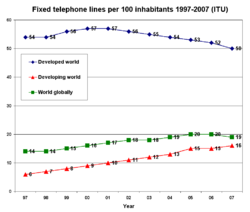Successors
voice over IP services can host landline numbers previously hosted on traditional fixed telephone networks. VoIP services can be used anywhere an Internet connection is available on many devices including smartphones, giving great flexibility to where calls may be answered and thus facilitating remote, mobile and home working, for example. VoIP porting allows landline numbers to remain in use, whilst freeing them from actual landlines tied to one location.
2000s


In many countries, landline service has not been readily available to most people. In some countries in Africa, the rise in cell phones has outpaced growth in landline service. Between 1998 and 2008, Africa added only 2.4 million landlines. [5] In contrast, between 2000 and 2008, cell phone use rose from fewer than 2 in 100 people to 33 out of 100. [5] There has also been a substantial decline of landline phones in the Indian subcontinent, in urban and even more in rural areas.
In the early 21st century, installations of landline telephones has declined due to the advancement of mobile network technology and the obsolescence of copper wire networking. It is more difficult to install landline copper wires to every user than it is to install transmission towers for mobile service that many people can connect to. Some predict that these metallic networks will be deemed completely out of date and replaced by more efficient broadband and fiber optic landline connections extending to rural areas and places where telecommunication was much more sparse. In 2009, The Economist wrote "At current rates the last landline in America will be disconnected sometime in 2025." [6]
In 2004, only about 45% of people in the United States between the ages of 12 and 17 owned cell phones. At that time, most had to rely on landline telephones. Just 4 years later, that percentage climbed to about 71%. That same year, 2008, about 77% of adults owned a mobile phone. [7]
2010s
In the year 2013, 91% of adults in the United States owned a mobile phone. Almost 60% of those with a mobile had a smartphone. [8] A National Health Interview Survey of 19,956 households by the Centers for Disease Control and Prevention released May 4, 2017 showed 45.9% of U.S. households still had landlines, while 50.8% had only cell phones. Over 39% had both. [9]
In Canada, more than one in five of households use cell phones as their only source for telephone service. In 2013, statistics showed that 21% of households claimed to only use cellular phones. [10] Households that are owned by members under the age of 35 have a considerably higher percentage of exclusive cell phone use. In 2013, 60% of young household owners claimed to only use cell phones. [11] In 2019, 54% of Canadian households [12] and 86.4% of German households [13] had a landline telephone.
2020s
In June 2020, it was reported that 60% of Australian adults used only mobile phones, with no landline. [14] In 2021, only 14.5% of Australian and 29.4% of American households used landline at home. [15] In contrast, 73% of UK households still had a landline connection in 2020 [16] though this could be in part explained by broadband packaging practices. [17] In 2022, 82.9% of German households had at least one landline phone [18] while 73% of U.S. households had only a cell phone, 25% had a landline and cell service, and 1% had only a landline. [19]
As of 2023, [update] Estonia and the Netherlands have retired the legacy parts of the public switched telephone network (PSTN). In the United Kingdom, the analogue copper landline network is due to be terminated in 2027 (delayed from the original 2025 plan). The VoIP replacement is known as "Digital Voice" (on a BT service) in the UK. France, Germany and Japan are also in the process of replacing theirs. [20]
Using primarily 2023 data, the CIA World Factbook reported approximately 849 million landlines worldwide. [21]